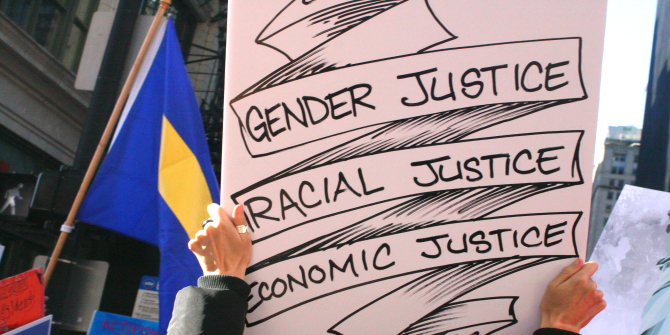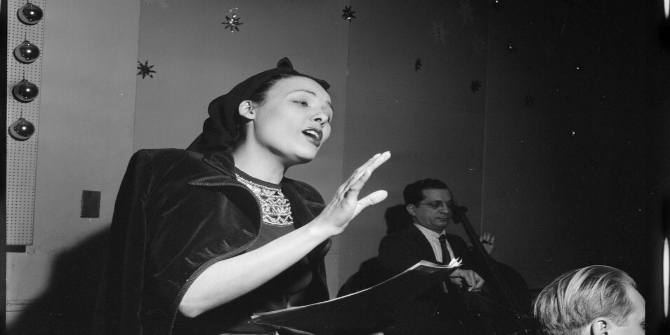In The Persistence of Gender Inequality, Mary Evans focuses on the continued structural inequalities between genders that go against optimistic narratives speaking only of inevitable progress and emancipation. This is a powerful and timely commentary on the persistence of inequalities throughout society that shows how tough the fight for equality has been – and may continue to be – as we collectively work to redefine the contours of our gendered political and social landscapes, writes Caroline Henaghan.
This review is published to mark International Women’s Day: a global day celebrating the economic, political and social achievements of women.
The Persistence of Gender Inequality. Mary Evans. Polity Press. 2017.
 Writing this review on the day of Donald Trump’s inauguration as the 45th President of the USA, I cannot help but admire the perspicacity of the author of The Persistence of Gender Inequality. While Mary Evans’s new book focuses more on the gendered social inequities faced by women in the twenty-first century rather than functioning as a purely political feminist text, it is a topical, timely and valuable addition to the arsenal of weaponry in the arena of women’s rights. Given recent events, it may not be long before we again find ourselves thrown to the metaphorical lions in the fight for equality. Whilst not explicitly provocative of such, this book may yet prove to be a warning to be heeded or even function as a tacit ‘call to arms’.
Writing this review on the day of Donald Trump’s inauguration as the 45th President of the USA, I cannot help but admire the perspicacity of the author of The Persistence of Gender Inequality. While Mary Evans’s new book focuses more on the gendered social inequities faced by women in the twenty-first century rather than functioning as a purely political feminist text, it is a topical, timely and valuable addition to the arsenal of weaponry in the arena of women’s rights. Given recent events, it may not be long before we again find ourselves thrown to the metaphorical lions in the fight for equality. Whilst not explicitly provocative of such, this book may yet prove to be a warning to be heeded or even function as a tacit ‘call to arms’.
When you first pick up a copy of this new text, turn straight to page eight. You might find yourself smiling ruefully at Evans’s references to the recent US Presidential elections, where she optimistically anticipates that, by the time of publication, the first woman – as opposed to just the First Lady – could be sitting in the White House. But would this have been a victory for gender equality? Given Hilary Clinton’s differential financial and social standing compared to most other women across the USA, Evans believes that this may not have been quite so. Perhaps then, at least, women in the UK can console themselves with the fact that here we now have a second female Prime Minister? Maybe; but again to Evans this could still represent an empty victory. Therein lies the rub of the social equality question and the thread that runs through the course of her narrative. Who is it in No. 10 that’s now wearing the – very, very expensive leather – trousers?
So, despite its title, this is not a book about gender politics per se. Instead Evans puts a different slant on some well-known political and academic issues by shining a new spotlight on gendered social inequality and the material and political disadvantages that still exist amongst some groups from the Global North to the Global South. Both historically and following the more recent rise of neoliberal capitalism, she asserts that even longstanding measures to allow for the legal equality of women, such as getting the right to vote, have really only served to act as what could be described as lip gloss covering a cracked facade beneath: that in fact ‘much social research suggests that, in the UK and the United States in particular, social inequality is actually increasing’ (16).
 Image Credit: Women’s March, 21 January 2017, Chicago (Jonathan Eyler-Werve CC BY 2.0)
Image Credit: Women’s March, 21 January 2017, Chicago (Jonathan Eyler-Werve CC BY 2.0)
Reading her book as a lawyer rather than a sociologist, I found the material, the methodological approach and Evans’s more nuanced arguments easy to follow and engage with. I appreciated her assertion that society has long assumed a steady march towards progress and equality from the works of Mary Wollstonecraft through to Simone de Beauvoir and beyond; but that actually patriarchy did not automatically disappear with the introduction of either the Sex Discrimination Act 1975 or the Equality Act 2010.
I also agreed with her claims that women everywhere now face even more threats to their position in society: with the onset and pressures of new media technologies; the dynamics of an increasing capitalised society where individualism and competition is ‘King’; the austerity measures that have followed a global financial meltdown; and an increasingly fragile state welfare support system here in the UK. I understood also the importance and emphasis that Evans places on the need to tackle the ‘Catch 22’ between a woman’s role as a supposedly free, emancipated (Marxist) worker and her assumed, residual commitments in the family home, where still little to no financial value is placed on the vital role of care. All these responsibilities leaving little or no time for the modern woman in her pursuit of the ‘body beautiful’ and the ‘good life’ which, as Chapter Three points out, the media constantly encourages her to participate in at every turn.
Thus are the arguments that Evans provides to guide us through the early sections, but it is Chapter Four – ‘Enter Feminism’– that drew my attention the most. On reading the proposition that ‘in some important ways [feminism] may assist the various forms of social inequality that support and sustain gender inequality’ (76) at the outset of the chapter, obviously I was keen to learn more. It is here that Evans provides us with a whistle-stop historical account of feminism right through to the 2014 campaign of T-shirt-wearing activists who told us: ‘This is what a feminist looks like’.
It is here, too, that one senses a change of tone, and it is here that I depart a little from Evans’s more forthright views. She suggests that when it comes to historical – and ongoing – perceptions of the movement, ‘feminism is somehow the location of a particular form of female failure: that of attracting male approval’ (94). ‘Approval’ here not only in a sexual sense, but also that approval which allows us to become a member of the educational or political ‘Old Boys’ Club’. This comment jumped off the page for me: particularly as it is contextualised only with regard to Evans’s exemplar assertion that it is still the case that ‘women within educational institutions conform to male expectations, and do so in order to receive forms of approval derived from the masculine’ (94). I struggle somewhat with this. It seems to me to be too sweeping a dismissive statement, too nihilistic a tone for my tastes, leaving no room for the argument that women, whatever their background, might just want to achieve autonomy – not approval – in its own right, much as men already do.
I accept Evans’s argument that in fighting the good feminist fight against misogyny, some feminists may have missed the proverbial boat of attempting to tackle social inequality at the same time. However, is this not a sign of the particular times or maybe missed opportunities, rather than an abject failure on the part of individual feminists or the ideology itself? That being said, it was that one statement in particular that drew me in to keep on reading, and in fact to specifically re-read her ‘Enter Feminism’ chapter, in order to fully appreciate Evans’s arguments: the key one concerning how ‘the importance […] of writing a feminist narrative which unites work on social inequality with the recognition of gender equality is now urgent’ (112). In a nutshell, this is the main theme – almost the manifesto statement – of the entire book, and one that is difficult to argue with.
Regardless of your gender, for those of you considering picking up a copy of The Persistence of Gender Inequality, I would suggest that you do so. From the outset the book does apply a somewhat pessimistic tone to the current social status quo, stating that ‘there is no country where gender equality has been achieved’ (viii) and carrying through to the text’s closing comments about a pressing need now for an ‘abandonment of fantasies about emancipation and progress’ (138). However, my reading and interpretation is that this was Evans’s primary aim: to provide an unapologetic, assertive commentary on the persisting social inequalities facing all in society, but most particularly the twenty-first-century woman. That she has certainly accomplished. The book is also a cry for a redefinition of the contours of the gendered political and social landscape, even if it does not contain a complete set of architectural plans for the project.
What Evans has done is provide us with a powerful and timely – if, on occasion, resolutely bleak – reminder of how hard women have already had to fight just to come this far in the feminist war. Perhaps even more importantly, in light of recent global events, Evans’s book may prove to have been a stark prediction too – that there could yet be worse to come for the post-postmodern woman on the frontlines of social justice and equality.
Caroline Henaghan is a Graduate Teaching & Research Assistant and Doctoral Candidate in the School of Law at The University of Manchester. With a professional background in law, her works focuses on issues of gender in the criminal law. Currently engaged in research on gender-specific criminal defences, Caroline is an enthusiastic advocate of women’s rights and tweets @ThePMDDDiary.
Note: This review gives the views of the author, and not the position of the LSE Review of Books blog, or of the London School of Economics.






